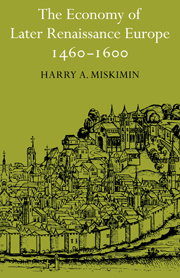Book contents
- Frontmatter
- Contents
- List of tables, graphs, maps
- Dedication
- Preface
- 1 The abstractions of law and property
- 2 Recovery: population and money supply
- 3 Agriculture: the rising demand for food
- 4 Industry: technology and organization
- 5 Trade patterns in the wider world
- 6 Finances: private and public
- 7 Retrospect
- Notes
- Bibliography
- Index
2 - Recovery: population and money supply
Published online by Cambridge University Press: 30 September 2009
- Frontmatter
- Contents
- List of tables, graphs, maps
- Dedication
- Preface
- 1 The abstractions of law and property
- 2 Recovery: population and money supply
- 3 Agriculture: the rising demand for food
- 4 Industry: technology and organization
- 5 Trade patterns in the wider world
- 6 Finances: private and public
- 7 Retrospect
- Notes
- Bibliography
- Index
Summary
In the year 1453, Constantinople fell, and after an effort that had required more than a century, the Turkish drive to conquer the eastern shores of the Mediterranean was complete. In the same year, the Hundred Years' War between France and England came to an end and peace allowed France to seek solutions to long-standing problems and to recover from the accumulated disasters of the preceding century. England too found internal peace in 1485, when the coronation of Henry VII instituted the Tudor monarchy and ended the civil distress known as the Wars of the Roses.
Foremost among the catastrophes that Europe had suffered in the century prior to 1450 was massive depopulation. Perhaps a third of the total population had perished as a result of the Black Death, or bubonic plague, whose first appearance in 1347–50 was reinforced and intensified by persistent recurrences at the national and local levels for more than a century. Normal demographic recovery through enhanced birthrates was impossible until the virulence of the plague subsided and immunity increased. As a result there is little doubt that the overall population of Europe was considerably smaller in the middle of the fifteenth century than it had been at the beginning of the fourteenth. Available numerical estimates do not withstand close scrutiny (figures offered by leading authors vary by as much as 50 percent), yet despite disparities in the actual numbers, they all confirm the same overall pattern.
- Type
- Chapter
- Information
- The Economy of Later Renaissance Europe 1460–1600 , pp. 20 - 46Publisher: Cambridge University PressPrint publication year: 1975



